Alcedinidae – Kingfishers
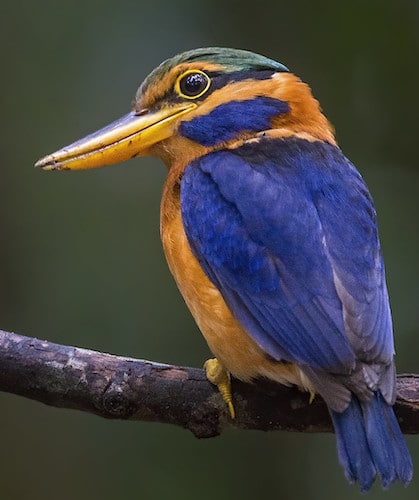
The Alcedinidae (Kingfishers) are a large family (119 species in three genera) of non-migratory, near-passerine birds found across all the world’s continents except Antarctica. They are Coraciiformes as are Brachypteraciidae (Ground Rollers), Coraciidae (Rollers), Momotidae (Motmots) and Meropidae (Bee-eaters).
They have a cosmopolitan distribution, with most species found outside of the Americas. The group is treated either as a single family, or as a suborder. Alcedines containing three broad families, although these are now lewss clearly defines – Alcedinidae (river kingfishers), Halcyonidae (tree kingfishers), and Cerylidae (water kingfishers).
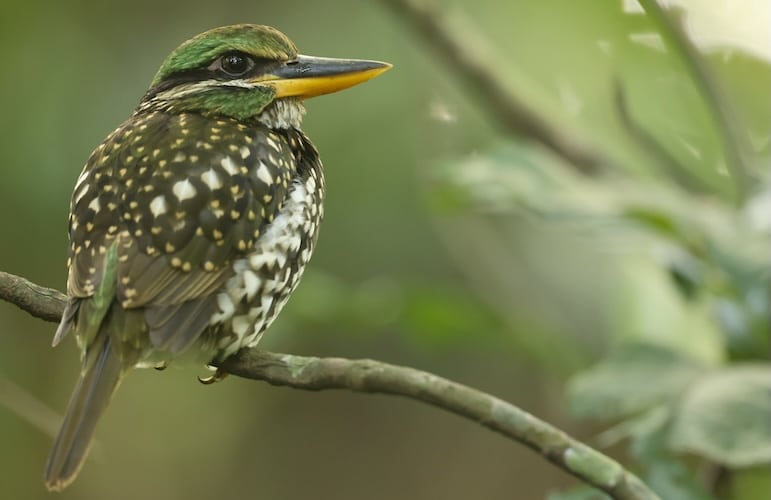
Spotted Wood Kingfisher Actenoides lindsayi – ©Bird-Photo-Tours ASIA
119 species of kingfishers are described. All have large heads, long, sharp, pointed bills, short legs, and stubby tails. Most species have bright plumage with few differences between the sexes. Most species are tropical in distribution, and a slight majority are found only in forests. They consume a wide range of prey, as well as fish, usually caught by swooping down from a perch. While kingfishers are usually thought to live near rivers and eat fish, most species live away from water and eat small invertebrates. Like other members of their order, they nest in cavities, usually tunnels dug into the natural or artificial banks in the ground. A quarter of all kingfishers, nest in abandoned termite nests. A few species, principally insular forms, are threatened with extinction. In Britain, the word ‘kingfisher’ normally refers to the Common Kingfisher – Alcedo atthis.
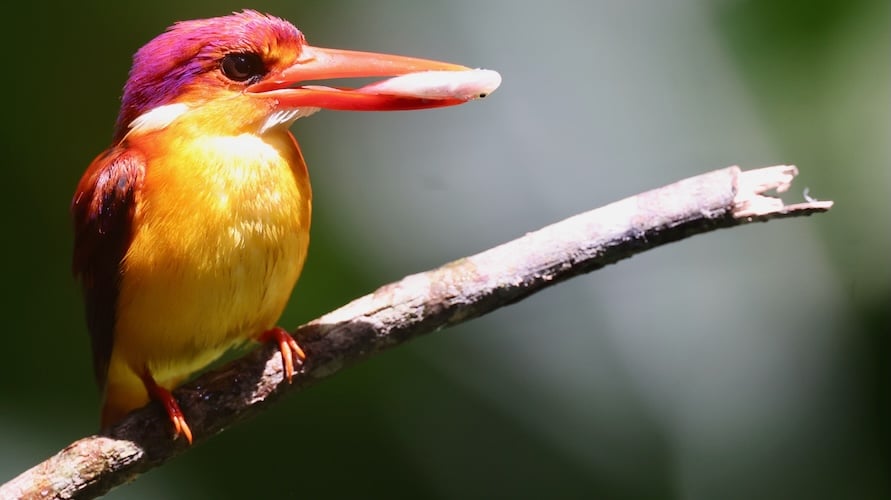
Oriental Dwarf Kingfisher Ceyx erithaca – ©Bird-Photo-Tours ASIA
The smallest species of kingfisher is the African Dwarf Kingfisher Ispidina lecontei, which averages 10.4g and 10 cm. The largest overall is the Giant Kingfisher Megaceryle maxima, at an average of 355g and 45cm. However, the familiar Australian kingfisher known as the Laughing Kookaburra Dacelo novaeguineae may be the heaviest species, since individuals exceeding 450g are not rare.
The plumage of most kingfishers is bright, with green and blue being the most common colours. The brightness of the colours is neither the product of iridescence (except in the American kingfishers) or pigments, but is instead caused by the structure of the feathers, which causes scattering of blue light (the Tyndall effect). In most species, no overt differences between the sexes exist; when differences occur, they are quite small (less than 10%). For example, in Alcedo atthis the difference between male and female is the just colour of the lower mandible.
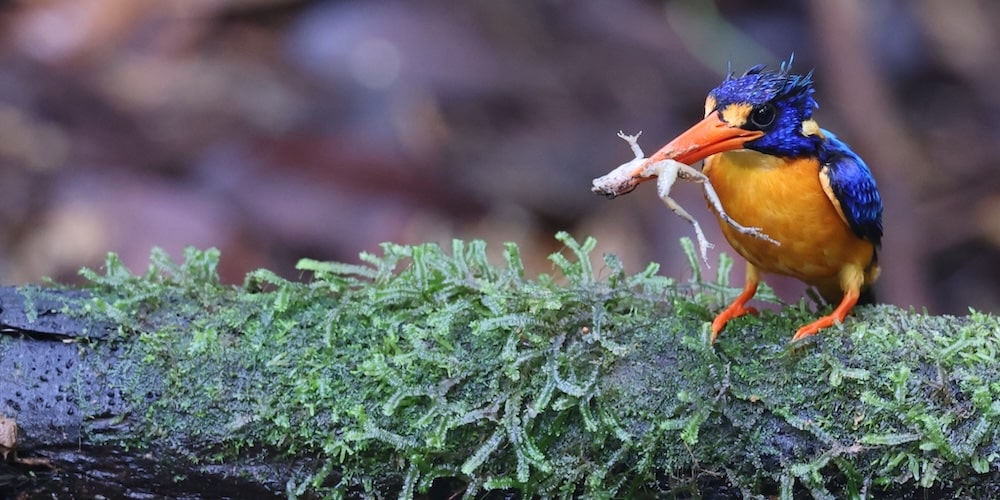
Manus Dwarf Kingfisher Ceyx dispar – ©Bird-Photo-Tours ASIA
The kingfishers have long, dagger-like bills. The bill is usually longer and more compressed in those species that hunt fish, but shorter and broader in species that hunt prey off the ground. The largest and most atypical bill is that of the Shovel-billed Kookaburra, which is used to dig through the forest floor in search of prey. Species generally have short legs, although species that feed on the ground have longer tarsi. Most species have four toes, three of which are forward-pointing.

Rufous-collared Kingfisher Actenoides concretus – ©Bird-Photo-Tours ASIA
The irises of most species are dark brown. The kingfishers have excellent vision; they are capable of binocular vision and are thought in particular to have good colour vision. They have restricted movement of their eyes within the eye sockets, instead using head movements to track prey. In addition, they are capable of compensating for the refraction of water and reflection when hunting prey underwater, and are able to judge depth under water accurately. They also have nictitating membranes that cover the eyes to protect them when they hit the water; the pied kingfisher has a bony plate which slides across the eye when it hits the water.
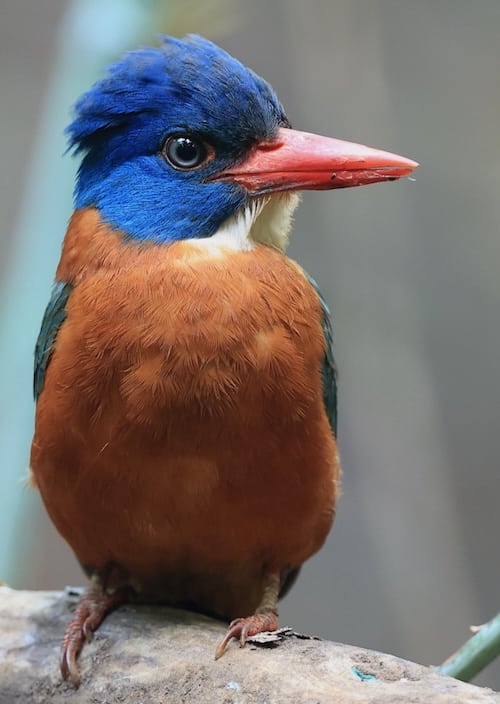
Green-backed Kingfisher Actenoides monachus – ©Bird-Photo-Tours ASIA
The kingfishers have a cosmopolitan distribution, occurring throughout the world’s tropical and temperate regions. They are absent from the polar regions and some of the world’s driest deserts. A number of species have reached islands groups, particularly those in the south and east Pacific Ocean. The Old-World tropics and Australasia are the core areas for this group. Europe and North America north of Mexico are very poorly represented, with only one common kingfisher species (Common Kingfisher and Belted Kingfisher respectively), and a couple of uncommon or very local species each: (Ringed Kingfisher and Green Kingfisher in the southwestern United States, Pied Kingfisher and White-throated Kingfisher in southeastern Europe). The six species occurring in the Americas are four closely related green kingfishers in the genus Chloroceryle and two large crested kingfishers in the genus Megaceryle. Even tropical South America has only five species plus the wintering Belted Kingfisher. In comparison, the African country of the Gambia has eight resident species in its 193 by 32 km area.
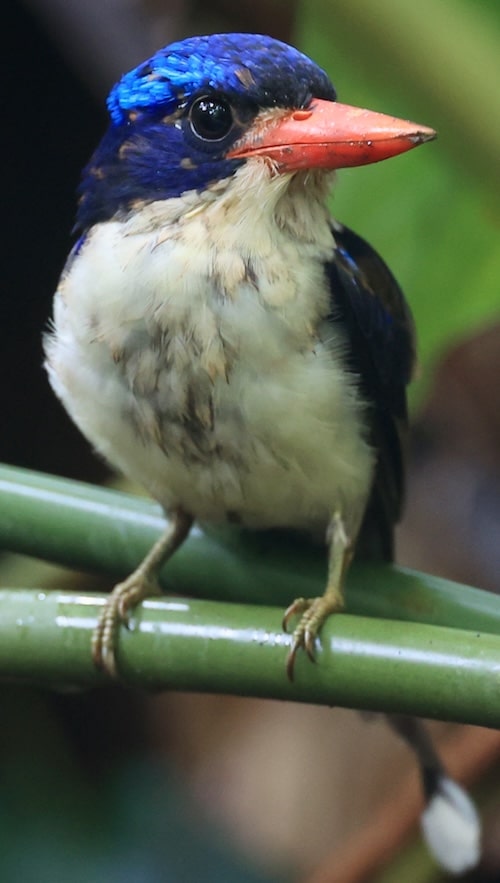
Common Paradise Kingfisher Tanysiptera galatea – ©Bird-Photo-Tours ASIA
Individual species may have massive ranges, like the Common Kingfisher, which ranges from Ireland across Europe, North Africa, and Asia as far as the Solomon Islands in Australasia, or the Pied Kingfisher, which has a widespread distribution across Africa and Asia. Other species have much smaller ranges, particularly insular species which are endemic to single small islands. For example, the Kofiau Paradise Kingfisher is restricted to the island of Kofiau off New Guinea.
Kingfishers occupy a wide range of habitats. While they are often associated with rivers and lakes, over half the world’s species are found in forests and along forested streams. They also occupy a wide range of other habitats. The Red-backed Kingfisher of Australia lives in the driest deserts, although kingfishers are absent from other dry deserts like the Sahara. Other species live high in mountains, or in open woodland, and a number of species live on tropical coral atolls. Numerous species have adapted to human-modified habitats, particularly those adapted to woodlands, and may be found in cultivated and agricultural areas, as well as parks and gardens in towns and cities.
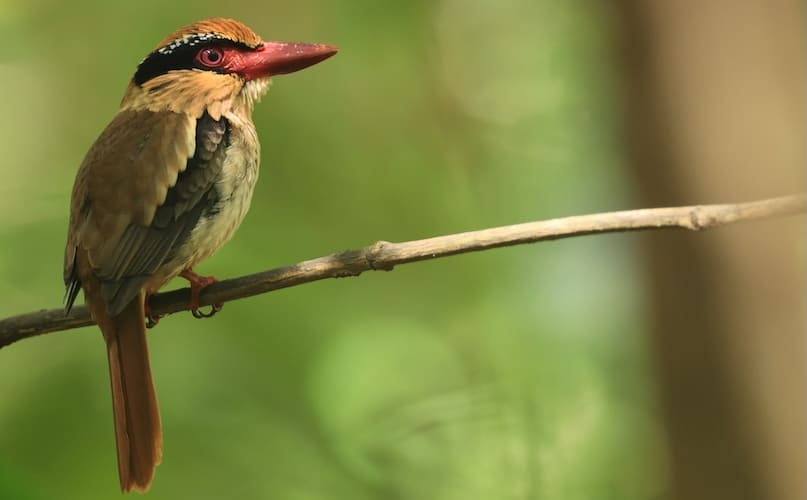
Sulawesi Lilac Kingfisher Cittura cyanotis – ©Bird-Photo-Tours ASIA
Kingfishers feed on a wide variety of prey. They are most famous for hunting and eating fish, and some species do specialise in catching fish, but other species take crustaceans, frogs and other amphibians, annelid worms, molluscs, insects, spiders, centipedes, reptiles (including snakes), and even birds and mammals. Individual species may specialise in a few items or take a wide variety of prey, and for species with large global distributions, different populations may have different diets. Woodland and forest kingfishers take mainly insects, particularly grasshoppers, whereas the water kingfishers are more specialised in taking fish. The Red-backed Kingfisher has been observed hammering into the mud nests of Fairy Martins to feed on their nestlings.
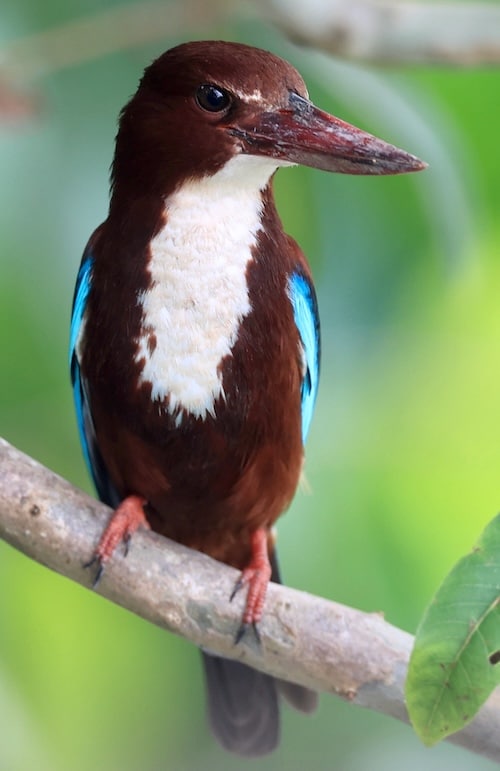
White-throated Kingfisher Halcyon smyrnensis – ©Bird-Photo-Tours ASIA
Kingfishers usually hunt from an exposed perch; when a prey item is observed, the kingfisher swoops down to snatch it, then returns to the perch. Kingfishers of all three sub-families beat larger prey on a perch to kill the prey and to dislodge or break protective spines and bones. Having beaten the prey, it is manipulated and then swallowed. The Shovel-billed Kookaburra uses its massive, wide bill as a shovel to dig for worms in soft mud.
Kingfishers are territorial, some species defending their territories vigorously. They are generally monogamous, although cooperative breeding has been observed in some species and is quite common in others, for example the Laughing Kookaburra, where helpers aid the dominant breeding pair in raising the young.
Like all Coraciiformes, the kingfishers are cavity nesters, with most species nesting in holes dug in the ground. These holes are usually in earth banks on the sides of rivers, lakes or man-made ditches. Some species may nest in holes in trees, the earth clinging to the roots of an uprooted tree, or arboreal nests of termites (termitarium). These termite nests are common in forest species. The nests take the form of a small chamber at the end of a tunnel. Nest-digging duties are shared between the sexes. During the initial excavations, the bird may fly at the chosen site with considerable force, and birds have injured themselves fatally while doing this. The length of the tunnels varies by species and location; nests in termitariums are necessarily much shorter than those dug into the earth, and nests in harder substrates are shorter than those in soft soil or sand. The longest tunnels recorded are those of the giant kingfisher, which have been found to be as much as 8.5 m long.
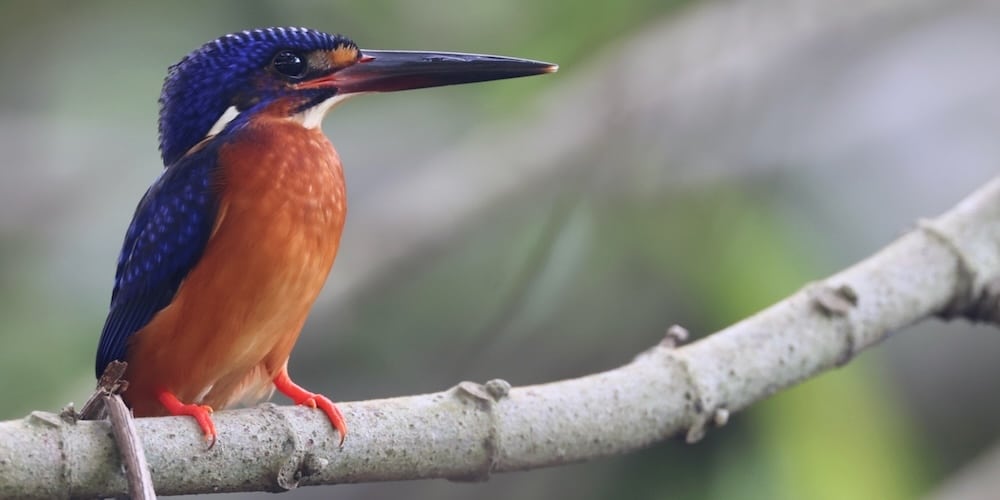
Blue-eared Kingfisher Alcedo meninting – ©Bird-Photo-Tours ASIA
The eggs of kingfishers are invariably white and glossy. The typical clutch size varies by species; some of the very large and very small species lay as few as two eggs per clutch, whereas others may lay as many as 10 eggs, the typical is around three to six eggs. Both sexes incubate the eggs. The offspring of the kingfisher usually stay with the parents for 3–4 months.
-
Number of bird species: 119
(As at Serptember 2025)
There are, according to the IOC, and other recent studies, 119 species of Kingfishers in 18 genera in the family Alcedinidae; they are listed below. (where a genus name appears in brackets it is because some authorities consider them to be a subspecies).
African Dwarf Kingfisher Ispidina lecontei
African Pygmy Kingfisher Ispidina picta
Madagascan Pygmy Kingfisher Corythornis madagascariensis
White-bellied Kingfisher Corythornis leucogaster
Malagasy Kingfisher Corythornis vintsioides
Malachite Kingfisher Corythornis cristatus
Javan Blue-banded Kingfisher Alcedo euryzona
Malaysian Blue-banded Kingfisher Alcedo peninsulae
Blyth’s Kingfisher Alcedo hercules
Blue-eared Kingfisher Alcedo meninting
Half-collared Kingfisher Alcedo semitorquata
Shining-blue Kingfisher Alcedo quadribrachys
Cerulean Kingfisher Alcedo coerulescens
Common Kingfisher Alcedo atthis
Azure Kingfisher Ceyx azureus
Bismarck Kingfisher Ceyx websteri
Indigo-banded Kingfisher Ceyx cyanopectus
Northern Silvery Kingfisher Ceyx flumenicola
Southern Silvery Kingfisher Ceyx argentatus
Little Kingfisher Ceyx pusillus
Oriental Dwarf Kingfisher Ceyx erithaca
Rufous-backed Dwarf Kingfisher Ceyx rufidorsa
Philippine Dwarf Kingfisher Ceyx melanurus
Sangihi Dwarf Kingfisher Ceyx sangirensis
Sulawesi Dwarf Kingfisher Ceyx fallax
Dimorphic Dwarf Kingfisher Ceyx margarethae
Sula Dwarf Kingfisher Ceyx wallacii
Moluccan Dwarf Kingfisher Ceyx lepidus
Buru Dwarf Kingfisher Ceyx cajeli
Papuan Dwarf Kingfisher Ceyx solitarius
Manus Dwarf Kingfisher Ceyx dispar
New Ireland Dwarf Kingfisher Ceyx mulcatus
New Britain Dwarf Kingfisher Ceyx sacerdotis
New Georgia Dwarf Kingfisher Ceyx collectoris
North Solomons Dwarf Kingfisher Ceyx meeki
Guadalcanal Dwarf Kingfisher Ceyx nigromaxilla
Malaita Dwarf Kingfisher Ceyx (nigromaxilla) malaitae
Makira Dwarf Kingfisher Ceyx gentianus
Belted Kingfisher Megaceryle alcyon
Ringed Kingfisher Megaceryle torquata
Giant Kingfisher Megaceryle maxima
Crested Kingfisher Megaceryle lugubris
Pied Kingfisher Ceryle rudis
Amazon Kingfisher Chloroceryle amazona
American Pygmy Kingfisher Chloroceryle aenea
Green Kingfisher Chloroceryle americana
Green-and-rufous Kingfisher Chloroceryle inda
Banded Kingfisher Lacedo pulchella
Brown-winged Kingfisher Pelargopsis amauroptera
Stork-billed Kingfisher Pelargopsis capensis
Great-billed Kingfisher Pelargopsis melanorhyncha
Ruddy Kingfisher Halcyon coromanda
Chocolate-backed Kingfisher Halcyon badia
Blue-breasted Kingfisher Halcyon malimbica
Mangrove Kingfisher Halcyon senegaloides
Woodland Kingfisher Halcyon senegalensis
Striped Kingfisher Halcyon chelicuti
Brown-hooded Kingfisher Halcyon albiventris
Grey-headed Kingfisher Halcyon leucocephala
Black-capped Kingfisher Halcyon pileata
Javan Kingfisher Halcyon cyanoventris
Brown-breasted Kingfisher Halcyon gularis
White-throated Kingfisher Halcyon smyrnensis
Sulawesi Lilac Kingfisher Cittura cyanotis
Sangihe Lilac Kingfisher Cittura sanghirensis
Little Paradise Kingfisher Tanysiptera hydrocharis
Common Paradise Kingfisher Tanysiptera galatea
Kofiau Paradise Kingfisher Tanysiptera ellioti
Biak Paradise Kingfisher Tanysiptera riedelii
Numfor Paradise Kingfisher Tanysiptera carolinae
Red-breasted Paradise Kingfisher Tanysiptera nympha
Brown-headed Paradise Kingfisher Tanysiptera danae
Buff-breasted Paradise Kingfisher Tanysiptera sylvia
Black-capped Paradise Kingfisher Tanysiptera nigriceps
Hook-billed Kingfisher Melidora macrorrhina
Laughing Kookaburra Dacelo novaeguineae
Blue-winged Kookaburra Dacelo leachii
Spangled Kookaburra Dacelo tyro
Rufous-bellied Kookaburra Dacelo gaudichaud
Shovel-billed Kookaburra Dacelo rex
Glittering Kingfisher Caridonax fulgidus
Moustached Kingfisher Actenoides bougainvillei
Rufous-collared Kingfisher Actenoides concretus
Spotted Wood Kingfisher Actenoides lindsayi
Hombron’s Kingfisher Actenoides hombroni
Green-backed Kingfisher Actenoides monachus
Scaly-breasted Kingfisher Actenoides princeps
Mountain Kingfisher Syma megarhyncha
Yellow-billed Kingfisher Syma torotoro
Blue-black Kingfisher Todiramphus nigrocyaneus
Winchell’s Kingfisher Todiramphus winchelli
Blue-and-white Kingfisher Todiramphus diops
Lazuli Kingfisher Todiramphus lazuli
Red-backed Kingfisher Todiramphus pyrrhopygius
Forest Kingfisher Todiramphus macleayii
White-mantled Kingfisher Todiramphus albonotatus
Ultramarine Kingfisher Todiramphus leucopygius
Vanuatu Kingfisher Todiramphus farquhari
Marquesan Kingfisher Todiramphus godeffroyi
Mewing Kingfisher Todiramphus ruficollaris
Society Kingfisher Todiramphus veneratus
Mangareva Kingfisher Todiramphus gambieri
Niau Kingfisher Todiramphus (gambieri) gertrudae
Chattering Kingfisher Todiramphus tutus
Pacific Kingfisher Todiramphus sacer
Rusty-capped Kingfisher Todiramphus pelewensis
Guam Kingfisher Todiramphus cinnamominus
Pohnpei Kingfisher Todiramphus reichenbachii
Flat-billed Kingfisher Todiramphus recurvirostris
Islet Kingfisher Todiramphus colonus
Torresian Kingfisher Todiramphus sordidus
Sacred Kingfisher Todiramphus sanctus
Collared Kingfisher Todiramphus chloris
Beach Kingfisher Todiramphus saurophagus
Mariana Kingfisher Todiramphus albicilla
Melanesian Kingfisher Todiramphus tristrami
Sombre Kingfisher Todiramphus funebris
Talaud Kingfisher Todiramphus enigma
Cinnamon-banded Kingfisher Todiramphus australasia
-
Halcyon Journey
| In Search of the Belted Kingfisher | By Marina Richie | 2022 | Oregon State University Press | Paperback | 251 pages, b/w illustrations | ISBN: 9780870712036 Buy this book from NHBS.com -
Kingfisher
| By Alan Marshall | 2021 | Mascot Media | Paperback | 168 pages, colour illustrations | ISBN: 9781916478381 Buy this book from NHBS.com -
Kingfisher
| By Ildiko Szabo | 2019 | Reaktion Books | Paperback | 199 pages, 90 colour & 10 b/w photos and illustrations | ISBN: 9781789141399 Buy this book from NHBS.com -
Kingfishers
| By Charlie Hamilton James | Colin Baxter Photography | 1997 | Paperback | 48 pages, Colour photos | Out of Print | ISBN: 9781900455251 Buy this book from NHBS.com -
Kingfishers and Kookaburras
| (Jewels of the Australian Bush ) | By David Hollands | New Holland Publishers | 1999 | Hardback | 132 pages, 100 col photos, maps | Out of Print | ISBN: 9781876334321 Buy this book from NHBS.com -
Kingfishers of the World
| By L Knowles & JW Nitchen | Times Editions | 1995 | Hardback | 196 pages, 100 colour illustrations, 93 maps | Out of Print | ISBN: 9789812044709 Buy this book from NHBS.com -
Kingfishers, Bee-eaters & Rollers
| By C Hiliary Fry, Kathie Fry & Alan Harris | Christopher Helm | 1999 | paperback | 328 pages, plates with colour illustrations | Out of Print | ISBN: 9780713652062 Buy this book from NHBS.com -
RSPB Spotlight: Kingfishers
| By David Chandler | 2020 | Bloomsbury | Paperback | 128 pages, 200 colour photos | ISBN: 9781472987617 Buy this book from NHBS.com
-
Menu Avibirds.com Search Menu The Vibrant World of Kingfishers (Alcedinidae) 2 comments The Vibrant World of Kingfishers (Alcedinidae)
WebpageThe Kingfishers are a diverse family of colorful birds. Once known as the halcyon bird in ancient Greece, these attractive birds have held a special presence in our lives throughout history. The name Halcyon would later be given to one of the three subfamilies. Kingfisher species are grouped into tree kingfishers, river kingfishers, and the piscivorous water kingfishers. There are 114 known species throughout the world. -
Alcedinidae
WebpageKingfishers -
Alcedinidae - The Kingfishers
WebpageAll about Kingfishers, of the avian family Alcedinidae.
Given the number of species in this large family, Fatbirder does not provide quick links to all of them. However, the entries below do include links to representatives of all genera, all those illustrated in the introduction and some of the most often encountered, iconic or sought-after species.
-
African Pygmy-Kingfisher Ispidina picta
Species AccountThe African pygmy kingfisher (Ispidina picta) is a small insectivorous kingfisher found in the Afrotropics, mostly in woodland habitats. Some texts refer to this species as Ceyx pictus. -
African Pygmy-Kingfisher Ispidina picta
Species AccountSound archive and distribution map. -
Amazon Kingfisher Chloroceryle amazona
Species AccountThe Amazon kingfisher (Chloroceryle amazona) is a resident breeding kingfisher in the lowlands of the American tropics from southern Mexico south through Central America to northern Argentina. -
Amazon Kingfisher Chloroceryle amazona
Cornell Species AccountThe Amazon Kingfisher is a resident of lakeshores and large-slow flowing rivers from northern Mexico south to central Argentina. -
American Pygmy Kingfisher Chloroceryle aenea
Cornell Species AccountThis tiny kingfisher is sparse, though perhaps often overlooked, throughout its large range in tropical lowlands. They are found along quiet streams in forest interior, as well as flooded várzea and swampy edges of lakes. -
American Pygmy Kingfisher Chloroceryle aenea
Species AccountSound archive and distribution map. -
Azure Kingfisher Alcedo azurea
Species AccountThe azure kingfisher (Ceyx azureus) is a small kingfisher (17–19 centimetres (6.7–7.5 in)), in the river kingfisher subfamily, Alcedininae. It is found in Northern and Eastern Australia and Tasmania, as well as the lowlands of New Guinea and neighbouring islands, and out to North Maluku and Romang. -
Azure Kingfisher Alcedo azurea
Species AccountThe Azure Kingfisher is a small kingfisher with a long slender black bill and a short tail. The head, neck, upper parts and breast sides are deep azure blue with a violet (purplish) sheen. -
Banded Kingfisher Lacedo pulchella
Species AccountThe banded kingfisher (Lacedo pulchella) is a tree kingfisher found in lowland tropical forests of southeast Asia. It is the only member of the genus Lacedo... -
Banded Kingfisher Lacedo pulchella
Species AccountSound archive and distribution map. -
Belted Kingfisher Megaceryle alcyon
Species AccountThe belted kingfisher (Megaceryle alcyon) is a large, conspicuous water kingfisher, the only member of that group commonly found in the northern United States and Canada -
Belted Kingfisher Megaceryle alcyon
Cornell Species AccountWith its top-heavy physique, energetic flight, and piercing rattle, the Belted Kingfisher seems to have an air of self-importance as it patrols up and down rivers and shorelines. -
Belted Kingfisher Megaceryle alcyon
Species AccountSound archive and distribution map. -
Black-capped Kingfisher Halcyon pileata
Species AccountThe black-capped kingfisher (Halcyon pileata) is a tree kingfisher which is widely distributed in tropical Asia from India east to China, Korea and Southeast Asia. -
Black-capped Kingfisher Halcyon pileata
Species AccountSound archive and distribution map. -
Blue-eared Kingfisher Alcedo meninting
Species AccountA diminutive dark blue kingfisher with no rufous on the ear-patch. It has an orange spot in front of the eye, white ear tufts on the sides of the neck. -
Blue-eared Kingfisher Alcedo meninting
Species AccountSound archive and distribution map. -
Blue-winged Kookaburra Dacelo leachii
Species AccountThe Blue-winged Kookaburra is a large kingfisher with a big square head and a long bill. It has a distinctive pale eye. The head is off-white with brown streaks, the shoulders are sky blue and it has a uniform blue rump. -
Blue-winged Kookaburra Dacelo leachii
Species AccountThe blue-winged kookaburra (Dacelo leachii) is a large species of kingfisher native to northern Australia and southern New Guinea. -
Blue-winged Kookaburra Dacelo leachii
Species AccountSound archive and distribution map. -
Brown-hooded Kingfisher Halcyon albiventris
Species AccountThe brown-hooded kingfisher (Halcyon albiventris) is a species of bird in the subfamily Halcyoninae. It is found in Angola, Botswana, Republic of the Congo, Democratic Republic of the Congo, Gabon, Kenya, Malawi, Mozambique, Namibia, Somalia, South Africa, Swaziland, Tanzania, Zambia, and Zimbabwe. -
Brown-hooded Kingfisher Halcyon albiventris
Species AccountSound archive and distribution map. -
Buff-breasted Paradise-Kingfisher Tanysiptera sylvia
Species AccountThe buff-breasted paradise-kingfisher (Tanysiptera sylvia) is a bird in the tree kingfisher subfamily, Halcyoninae. -
Buff-breasted Paradise-Kingfisher Tanysiptera sylvia
Species AccountSound archive and distribution map. -
Cinnamon-banded Kingfisher Todiramphus australasia
Species AccountSound archive and distribution map. -
Cinnamon-banded Kingfisher Todiramphus australasia
Species AccountThe cinnamon-banded kingfisher (Todiramphus australasia) is a species of bird in the family Alcedinidae. It is found in Indonesia and East Timor. -
Collared Kingfisher Halcyon chloris
Species Accounthe collared kingfisher (Todiramphus chloris) is a medium-sized kingfisher belonging to the subfamily Halcyoninae, the tree kingfishers. It is also known as the white-collared kingfisher or mangrove kingfisher. -
Collared Kingfisher Todirhamphus chloris
IUCN Species Status -
Collared Kingfisher Todirhamphus chloris
Species AccountSound archive and distribution map. -
Common Kingfisher Alcedo atthis
Species AccountThe common kingfisher (Alcedo atthis) also known as the Eurasian kingfisher, and river kingfisher, is a small kingfisher with seven subspecies recognized within its wide distribution across Eurasia and North Africa. It is resident in much of its range, but migrates from areas where rivers freeze in winter. -
Common Kingfisher Alcedo atthis
RSPB Species AccountKingfishers are small unmistakable bright blue and orange birds of slow moving or still water. -
Common Kingfisher Alcedo atthis
Species AccountSound archive and distribution map. -
Common Paradise Kingfisher anysiptera galatea
eBird Species AccountA long-tailed kingfisher of lowland forests. White underparts and rump, dark blue upperparts with pale blue shoulder and crown. -
Common Paradise Kingfisher anysiptera galatea
Species AccountSong, Distribution etc -
Crested Kingfisher Megaceryle lugubris
Species AccountSound archive and distribution map. -
Crested Kingfisher Megaceryle lugubris
IUCN Species Status -
Crested Kingfisher Megaceryle lugubris
Species AccountThe crested kingfisher (Megaceryle lugubris) is a very large kingfisher that is native to parts of southern Asia, stretching eastwards from the Indian Subcontinent towards Japan. -
Forest Kingfisher Todirhamphus macleayii
Species AccountThe forest kingfisher (Todiramphus macleayii), also known as the Macleay's or blue kingfisher, is a species of kingfisher in the subfamily Halcyoninae, also known as tree kingfishers. It is a predominantly blue and white bird. It is found in Indonesia, New Guinea and coastal eastern and northern Australia. Like many other kingfishers, it hunts invertebrates and small frogs and lizards. -
Forest Kingfisher Todirhamphus macleayii
Species AccountThe Forest Kingfisher has a dark royalblue head with pale turquoise on the back.There is a large white spot over the bill. The underparts are white. -
Giant Kingfisher Megaceryle maxima
Species AccountThe giant kingfisher (Megaceryle maxima) is the largest kingfisher in Africa, where it is a resident breeding bird over most of the continent south of the Sahara Desert other than the arid southwest. -
Giant Kingfisher Megaceryle maxima
Species AccountSound archive and distribution map. -
Green Kingfisher Chloroceryle americana
Species AccountThe green kingfisher (Chloroceryle americana) is a resident breeding bird which occurs from southern Texas in the United States south through Central and South America to central Argentina. -
Green Kingfisher Chloroceryle americana
Cornell Species AccountA widespread resident of the Neotropics, the Green Kingfisher can be found from south Texas and southeastern Arizona in the United States south to northern Chile and Argentina. -
Green-and-rufous Kingfisher Chloroceryle inda
eBird Species AccountFairly small kingfisher, unique with its green back and entirely rufous belly. -
Green-and-rufous Kingfisher Chloroceryle inda
Species AccountSong, distribution etc... -
Green-backed Kingfisher Actenoides monachus
eBird Species AccountAn unmistakable, spectacular large forest kingfisher with a big orange bill, a moss-green back, burnt-orange underparts, and a white throat. -
Green-backed Kingfisher Actenoides monachus
Species AccountSound archive and distribution map. -
Grey-headed Kingfisher Halcyon leucocephala
Species AccountSound archive and distribution map -
Grey-headed Kingfisher Halcyon leucocephala
Species Accounthttps://en.wikipedia.org/wiki/Grey-headed_kingfisher -
Grey-headed Kingfisher Halcyon leucocephala
IUCN Species StatusIUCN species profile -
Hook-billed Kingfisher Melidora macrorrhina
Species AccountThick, bicolored bill with a distinct hook, dark wing with large brown spots, black face with a pale stripe below the eye and a finely speckled crown. -
Hook-billed Kingfisher Melidora macrorrhina
Species AccountSound archive and distribution map. -
Laughing Kookaburra Dacelo novaeguineae
Species AccountThe laughing kookaburra (Dacelo novaeguineae) is a carnivorous bird in the kingfisher subfamily Halcyoninae. Native to eastern mainland Australia, it has also been introduced to parts of New Zealand, Tasmania, and Western Australia. Male and female adults are similar in plumage, which is predominantly brown and white. A common and familiar bird, this species of kookaburra is well known for its laughing call. -
Little Kingfisher Ceyx pusilla
Species AccountThe little kingfisher (Ceyx pusillus) is a species of bird in the family Alcedinidae. It is found in open forest, woodland, swamps and mangroves in Australia (northern Queensland and north Northern Territory), Indonesia, Papua New Guinea and the Solomon Islands. -
Malachite Kingfisher Corythornis cristata
Species AccountThe malachite kingfisher (Corythornis cristatus) is a river kingfisher which is widely distributed in Africa south of the Sahara. It is largely resident except for seasonal climate-related movements. -
Manus Dwarf Kingfisher Ceyx dispar
Species AccountThe Manus dwarf kingfisher (Ceyx dispar), is a species of bird in the family Alcedinidae that is endemic to the Admiralty Islands. -
Manus Dwarf Kingfisher Ceyx dispar
Species AccountSound archive and distribution map. -
Micronesian Kingfisher Todirhamphus cinnamominus
Species AccountThe Micronesian Kingfisher, Todiramphus cinnamominus, is a species of kingfisher from the Pacific Islands of Guam, Pohnpei and Palau. One of its subspecies, the Guam Kingfisher, is restricted to a captive breeding program following its extinction in the wild due to the introduced brown tree snake… -
Oriental Dwarf Kingfisher Ceyx erithaca
Species AccountThe black-backed dwarf kingfisher (Ceyx erithaca), also known as the three-toed kingfisher, is a pocket-sized bird in the family Alcedinidae. -
Oriental Dwarf Kingfisher Ceyx erithaca
Species AccountSound archive and distribution map. -
Pied Kingfisher Ceryle rudis
Species AccountThe pied kingfisher (Ceryle rudis) is a water kingfisher and is found widely distributed across Africa and Asia. Its black and white plumage, crest and the habit of hovering over clear lakes and rivers before diving for fish make it distinctive. Males have a double band across the breast while females have a single gorget that is often broken in the middle. They are usually found in pairs or small family parties. When perched, they often bob their head and flick up their tail. -
Pied Kingfisher Ceryle rudis
BirdLife Species AccountFull species account... -
Red-backed Kingfisher Todiramphus pyrrhopygius
Species AccountDesert kingfisher with a strong black eye-line occurring across most of the drier parts of Australia. -
Red-backed Kingfisher Todiramphus pyrrhopygius
Species AccountDistribution, song etc -
Ringed Kingfisher Megaceryle torquata
Species AccountThe ringed kingfisher (Megaceryle torquata) is a large, conspicuous and noisy kingfisher commonly found along the lower Rio Grande valley in southeasternmost Texas in the United States through Central America to Tierra del Fuego in South America. -
Ringed Kingfisher Megaceryle torquata
Cornell Species AccountThe Ringed Kingfisher is the largest kingfisher in the Americas. Its heavy, pale-based bill, disheveled crest, blue-gray plumage, white collar, and red belly are visible and recognizable even at a distance. -
Ringed Kingfisher Megaceryle torquata
Species AccountSound archive and distribution map. -
Ruddy Kingfisher Halcyon coromanda
Species AccountThe ruddy kingfisher (Halcyon coromanda) is a medium-sized tree kingfisher which is widely distributed in east and southeast Asia, ranging from South Korea and Japan in the north, south through the Philippines to the Sunda Islands, and west to China and India. -
Ruddy Kingfisher Halcyon coromanda
Species AccountSound archive and distribution map. -
Rufous-collared Kingfisher Actenoides concretus
Species AccountThe rufous-collared kingfisher (Actenoides concretus) is a species of bird in the family Alcedinidae. It is found in Brunei, Indonesia, Malaysia, Myanmar... -
Rufous-collared Kingfisher Actenoides concretus
Species AccountSound archive and distribution map. -
Sacred Kingfisher Todirhamphus sanctus
Species AccountSound archive and distribution map. -
Sacred Kingfisher Todirhamphus sanctus
Species AccountThe sacred kingfisher (Todiramphus sanctus) is a medium-sized woodland kingfisher that occurs in mangroves, woodlands, forests, and river valleys in Australia, New Zealand, and other parts of the western Pacific. In New Zealand the species is also known by its Māori name kōtare. -
Sacred Kingfisher Todirhamphus sanctus
Species AccountThe Sacred Kingfisher is a medium sized kingfisher. It has a turquoise back, turquoise blue rump and tail, buff-white underparts and a broad cream collar. -
Spangled Kookaburra Dacelo tyro
Species AccountThe spangled kookaburra (Dacelo tyro) also called Aru giant kingfisher, is a little-known, but spectacular species of kookaburra found in the Aru Islands, Trans Fly savanna and grasslands of southern New Guinea and Australia. It has bright blue wings and tail, a white chest and belly, dark eyes, and a striking white-spotted black head. Practically nothing is known of its family life or breeding biology. -
Spangled Kookaburra Dacelo tyro
Species AccountSound archive and distribution map. -
Spotted Wood Kingfisher Actenoides lindsayi
Species AccountA striking medium-sized kingfisher of lowland and foothill forest. Whitish below with dark scaling and dark green above with buff spotting. -
Spotted Wood Kingfisher Actenoides lindsayi
Species AccountSound archive and distribution map. -
Stork-billed Kingfisher Pelargopsis capensis
Species AccountThe stork-billed kingfisher (Pelargopsis capensis, formerly Halcyon capensis), is a tree kingfisher which is widely but sparsely distributed in the tropical Indian subcontinent and Southeast Asia, from India to Indonesia. This kingfisher is resident throughout its range. -
Stork-billed Kingfisher Pelargopsis capensis
IUCN Species Status -
Stork-billed Kingfisher Pelargopsis capensis
Species AccountSound archive and distribution map. -
Striped Kingfisher Halcyon chelicuti
Species AccountSound archive and distribution map. -
Striped Kingfisher Halcyon chelicuti
Species AccountThe striped kingfisher (Halcyon chelicuti) is a species of bird in the tree kingfisher subfamily. It was first described by Edward, Lord Stanley, in Salt's Voyage to Abyssinia. -
Striped Kingfisher Halcyon chelicuti
BirdLife Species AccountBirdLife species profile... -
Sulawesi Lilac Kingfisher Cittura cyanotis
Species AccountA unique forest kingfisher. Largely pale brown with an eye-catching red bill, a prominent dark mask with pale flecks on its upper border, dark wings... -
Sulawesi Lilac Kingfisher Cittura cyanotis
Species AccountSound archive and distribution map. -
White-rumped Kingfisher Caridonax fulgidus
Species AccountThe glittering kingfisher or white-rumped kingfisher (Caridonax fulgidus) is a species of bird in the Alcedinidae family. It is monotypic within the genus Caridonax.[2] It is endemic to Indonesia, where its natural habitats are subtropical or tropical moist lowland forests and subtropical or tropical moist montane forests.… -
White-throated Kingfisher Halcyon smyrnensis
Species AccountThe white-throated kingfisher (Halcyon smyrnensis) also known as the white-breasted kingfisher or Smyrna kingfisher, is a tree kingfisher,[2] widely distributed in Asia from Turkey east through the Indian subcontinent to the Philippines. -
White-throated Kingfisher Halcyon smyrnensis
Species AccountSound archive and distribution map. -
Woodland Kingfisher Halcyon senegalensis
BirdLife Species AccountBirdLife species profile... -
Woodland Kingfisher Halcyon senegalensis
Species AccountThe woodland kingfisher (Halcyon senegalensis) is a tree kingfisher. -
Woodland Kingfisher Halcyon senegalensis
Species AccountSound archive and distribution map. -
Yellow-billed Kingfisher Syma torotoro
Species AccountSmall green kingfisher with orange head and bright yellow bill, found in wet rainforest on Cape York Peninsula and in New Guinea. In flight, note uniformly... -
Yellow-billed Kingfisher Syma torotoro
Species AccountSound archive and distribution map.
-
Kingfishers and their related birds
WebsiteSome images…
